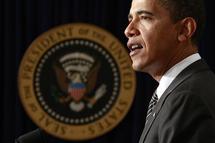
"For the first time in decades, the United States at the highest-ranking level has agreed to recognise co-responsibility in the drug trade," said Rosanna Fuentes-Berain, editor of the Spanish edition of Foreign Affairs.
During her Mexico trip last month, US Secretary of State Hillary Clinton promised financing for US-made Blackhawk helicopters on top of a 1.4-billion-dollar US plan to help train and equip Mexican anti-drug forces known as the Merida Initiative, which still needs to be fully approved by Congress.
But more than aid promises, Mexico has welcomed a change in tack.
"The difference is insubstantial in terms of money," Fuentes-Berain said. "What is important is the tone."
Clinton admitted that US demand for illegal drugs and its inability to prevent illegal weapons smuggling had contributed to violence in which almost 7,000 have died in Mexico since the start of 2008.
The US Bureau of Alcohol, Tobacco and Firearms estimates that around 90 percent of weapons confiscated in Mexico come from the United States.
While a US curb on weapons sales remains highly controversial, the US Senate voted this month for a 550-million-dollar package to stop the southward traffic of guns and money, and top US officials agreed in Mexico to combine efforts to stop the firearms flow across the 3,000-plus kilometer (2,000-mile) border.
Obama last month announced extra agents for the US border to tackle the spillover of cartel violence, and also vowed to staunch demand in the world's largest consumer of illegal narcotics.
Mexican President Felipe Calderon -- who has gambled his presidency on the battle against drug trafficking with the deployment of more than 36,000 troops -- praised the "constructive attitude" of the Obama administration.
Trade, the economic crisis and immigration are also key issues in the closely-tied countries.
Trade relations have been tense since Mexico last month slapped some 2.4 billion dollars in tariffs on 89 US products after the cancellation of a program authorizing some Mexican trucks to operate in the United States.
The US move violated the North American Free Trade Agreement, and Mexico's retaliation sparked a first trade challenge for Obama, with more than 150 industrial giants calling for an end to the spat.
Mexico, Latin America's second biggest economy, depends on the United States for 80 percent of its exports and most of its remittances, with some 12 million legal and illegal Mexicans in the United States.
Immigration reform is also on the agenda of the April 16-17 visit.
The New York Times last week reported that Obama aims to draft legislation this year allowing illegal immigrants to become legal citizens in a major overhaul of the US immigration system, which would clearly impact Mexicans, the largest immigrant group in the country.
The US president is due to travel from Mexico to Trinidad and Tobago for a first summit with Latin American leaders on April 17.
------------------------------------------------------------------------------------------
During her Mexico trip last month, US Secretary of State Hillary Clinton promised financing for US-made Blackhawk helicopters on top of a 1.4-billion-dollar US plan to help train and equip Mexican anti-drug forces known as the Merida Initiative, which still needs to be fully approved by Congress.
But more than aid promises, Mexico has welcomed a change in tack.
"The difference is insubstantial in terms of money," Fuentes-Berain said. "What is important is the tone."
Clinton admitted that US demand for illegal drugs and its inability to prevent illegal weapons smuggling had contributed to violence in which almost 7,000 have died in Mexico since the start of 2008.
The US Bureau of Alcohol, Tobacco and Firearms estimates that around 90 percent of weapons confiscated in Mexico come from the United States.
While a US curb on weapons sales remains highly controversial, the US Senate voted this month for a 550-million-dollar package to stop the southward traffic of guns and money, and top US officials agreed in Mexico to combine efforts to stop the firearms flow across the 3,000-plus kilometer (2,000-mile) border.
Obama last month announced extra agents for the US border to tackle the spillover of cartel violence, and also vowed to staunch demand in the world's largest consumer of illegal narcotics.
Mexican President Felipe Calderon -- who has gambled his presidency on the battle against drug trafficking with the deployment of more than 36,000 troops -- praised the "constructive attitude" of the Obama administration.
Trade, the economic crisis and immigration are also key issues in the closely-tied countries.
Trade relations have been tense since Mexico last month slapped some 2.4 billion dollars in tariffs on 89 US products after the cancellation of a program authorizing some Mexican trucks to operate in the United States.
The US move violated the North American Free Trade Agreement, and Mexico's retaliation sparked a first trade challenge for Obama, with more than 150 industrial giants calling for an end to the spat.
Mexico, Latin America's second biggest economy, depends on the United States for 80 percent of its exports and most of its remittances, with some 12 million legal and illegal Mexicans in the United States.
Immigration reform is also on the agenda of the April 16-17 visit.
The New York Times last week reported that Obama aims to draft legislation this year allowing illegal immigrants to become legal citizens in a major overhaul of the US immigration system, which would clearly impact Mexicans, the largest immigrant group in the country.
The US president is due to travel from Mexico to Trinidad and Tobago for a first summit with Latin American leaders on April 17.
------------------------------------------------------------------------------------------









 Home
Home Politics
Politics









